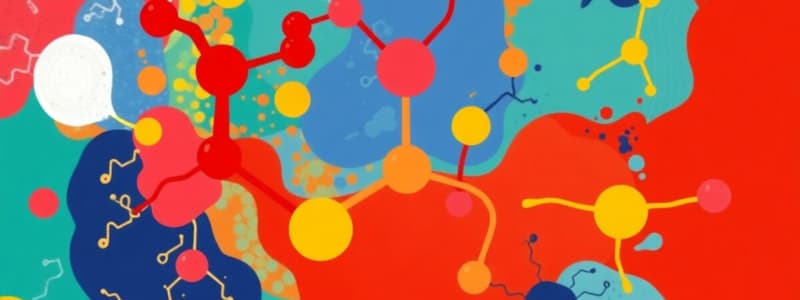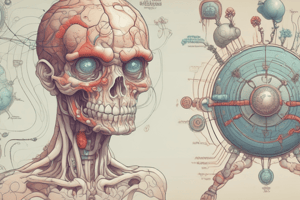Podcast
Questions and Answers
What initiates the signaling cascade when polypeptide hormones bind to their receptors?
What initiates the signaling cascade when polypeptide hormones bind to their receptors?
- Transfer of phosphate molecules (correct)
- Electrochemical signals
- Hormone secretion
- Direct gene activation
Which of the following is an example of a pathway involved in the signaling cascade of polypeptide hormones?
Which of the following is an example of a pathway involved in the signaling cascade of polypeptide hormones?
- Cyclic AMP signaling pathway (correct)
- Krebs cycle
- Electron transport chain
- Glycolysis pathway
In which type of signaling do polypeptide hormones primarily engage?
In which type of signaling do polypeptide hormones primarily engage?
- Autocrine signaling
- Extracellular signaling (correct)
- Ligand-gated signaling
- Intracellular signaling
What is the role of 2nd messengers in the signaling cascade initiated by polypeptide hormones?
What is the role of 2nd messengers in the signaling cascade initiated by polypeptide hormones?
Which pathway is associated specifically with insulin signaling?
Which pathway is associated specifically with insulin signaling?
What type of hormones are primarily mentioned in the context of signaling pathways?
What type of hormones are primarily mentioned in the context of signaling pathways?
Which signaling pathway is involved in cytokine interactions?
Which signaling pathway is involved in cytokine interactions?
What kind of signaling is exemplified by the process of kinase reactions in polypeptide hormone signaling?
What kind of signaling is exemplified by the process of kinase reactions in polypeptide hormone signaling?
What is the primary function of steroid hormones in muscle fibers?
What is the primary function of steroid hormones in muscle fibers?
Which statement describes polypeptide hormones?
Which statement describes polypeptide hormones?
What initiates the transcription of a gene in response to a steroid hormone?
What initiates the transcription of a gene in response to a steroid hormone?
Which of the following is NOT a type of hormone listed?
Which of the following is NOT a type of hormone listed?
What is the role of mRNA in the process of protein synthesis following steroid hormone activation?
What is the role of mRNA in the process of protein synthesis following steroid hormone activation?
What do amine hormones primarily consist of?
What do amine hormones primarily consist of?
Which hormone derived from the adrenal medulla is crucial for the body's fight-or-flight response?
Which hormone derived from the adrenal medulla is crucial for the body's fight-or-flight response?
What is the main source from which steroid hormones are synthesized?
What is the main source from which steroid hormones are synthesized?
Flashcards
Steroid Hormones
Steroid Hormones
Hormones derived from cholesterol that bind to intracellular receptors and require transport proteins.
Polypeptide Hormones
Polypeptide Hormones
Hormones made of amino acid chains that bind to extracellular receptors and use second messengers to influence cellular activity.
Amine Hormones
Amine Hormones
Hormones derived from amino acids, including thyroid hormones (T3, T4) and adrenal medulla hormones (epinephrine, norepinephrine).
Hormone-Receptor Complex (H-RC)
Hormone-Receptor Complex (H-RC)
Signup and view all the flashcards
Transcription
Transcription
Signup and view all the flashcards
Translation
Translation
Signup and view all the flashcards
What happens when a steroid hormone binds to its receptor in a muscle fiber?
What happens when a steroid hormone binds to its receptor in a muscle fiber?
Signup and view all the flashcards
Describe the central dogma of genetics in the context of steroid hormone action.
Describe the central dogma of genetics in the context of steroid hormone action.
Signup and view all the flashcards
Second Messengers
Second Messengers
Signup and view all the flashcards
cAMP Signaling Pathway
cAMP Signaling Pathway
Signup and view all the flashcards
Insulin Signaling Pathway
Insulin Signaling Pathway
Signup and view all the flashcards
mTOR Signaling Pathway
mTOR Signaling Pathway
Signup and view all the flashcards
JAK/STAT Signaling Pathway
JAK/STAT Signaling Pathway
Signup and view all the flashcards
Anterior Pituitary
Anterior Pituitary
Signup and view all the flashcards
Posterior Pituitary
Posterior Pituitary
Signup and view all the flashcards
Study Notes
Hormone Types
- Two main classes of hormones exist: peptides and steroids.
- Peptide hormones bind to receptors on the outside of the cell, triggering a cascade of intracellular reactions.
- Steroid hormones diffuse across cell membranes and bind to intracellular receptors.
- Various signaling cascades exist, each affecting different target cells.
Steroid Hormones
- Derived from cholesterol, they circulate in the blood bound to transport proteins.
- They bind to intracellular receptors, directly affecting gene expression.
- These hormones influence multiple physiological processes.
Polypeptide Hormones
- Composed of amino acid chains, they bind to receptors on the cell surface.
- This binding initiates intracellular signaling cascades, often utilizing second messengers, to affect gene expression.
Cyclic AMP
- A second-messenger system crucial for polypeptide hormone function.
- It relies on adenylate cyclase activating to convert ATP to cAMP within the cell.
- cAMP activates protein kinases, which lead to a cascade of cellular changes and hormonal effects.
Insulin Signaling Cascade
- A complex pathway involving multiple steps and proteins.
- This involves receptors, IRS, PI3K, and ultimately, AKT and downstream signaling molecules.
- This pathway plays a role in glucose uptake and cellular metabolism.
Studying That Suits You
Use AI to generate personalized quizzes and flashcards to suit your learning preferences.




